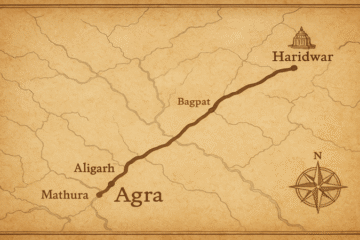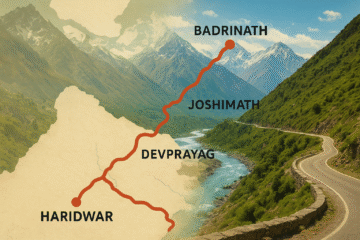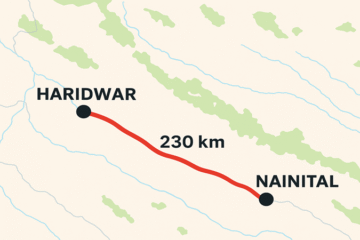
Table of Contents
The Himalayas are home to some of India’s most breathtaking landscapes, and at the heart of this stunning region are two of its most celebrated hill stations: Kullu-Manali and Shimla. While Kullu-Manali is a haven for adventure seekers and nature lovers with its snow-capped peaks, lush valleys, and gushing rivers, Shimla captivates with its colonial charm, architectural heritage, and bustling Mall Road. For many travelers, the ultimate Himachal Pradesh experience involves visiting both destinations, a journey that connects the serene beauty of the Beas Valley with the majestic grandeur of the Shimla hills. Understanding the logistics of this trip, particularly the distance from Kullu Manali to Shimla, is the first and most crucial step in planning a memorable adventure. This comprehensive guide will provide a detailed overview of the routes, travel options, and everything you need to know to make your journey as smooth and enjoyable as the destination itself.
The Primary Route: Via Mandi and Bilaspur
The most common and efficient way to travel from Kullu Manali to Shimla is by road, following a well-defined route that takes you through the heart of the state. The approximate distance from Kullu Manali to Shimla on this primary route is about 250 kilometers, and the journey typically takes anywhere from 7 to 8 hours, depending on road conditions, traffic, and the number of stops you make along the way.
The journey begins in Manali, from where you’ll head south towards Kullu, the administrative center of the valley. This initial stretch is short but scenic, running parallel to the Beas River. From Kullu, the road continues its winding descent, and you’ll eventually arrive at Mandi, a significant commercial hub often referred to as the “Varanasi of the Hills” due to its numerous ancient temples situated on the banks of the Beas.
After Mandi, the route proceeds towards Sundernagar and then Bilaspur, where you’ll get a glimpse of the vast Gobind Sagar Lake, a man-made reservoir created by the Bhakra Dam. The landscape here begins to change, transitioning from the narrow, steep-sided valleys of Kullu to more open, rolling hills. This section of the journey is characterized by well-maintained highways, although it’s important to remember that mountain roads always require cautious driving. The final leg of the trip from Bilaspur to Shimla involves a steady ascent, taking you through charming villages and dense forests of pine and deodar before you reach the ‘Queen of Hills.’
The road quality on this route is generally good, consisting of a mix of national and state highways. However, during the monsoon season (typically from July to September), landslides and flash floods are a frequent occurrence, especially along the Chandigarh-Manali highway, which is a key part of this route. It is imperative to check for real-time road status updates and weather forecasts before embarking on your journey during this time. The Himachal Pradesh State Road Transport Corporation (HRTC) website and local news outlets are excellent sources for this information.
Modes of Transport: Choosing Your Journey Style
Manali to Shimla distance can be covered in several ways, each offering a distinct experience. Your choice of transport will largely depend on your budget, comfort preferences, and the amount of time you have.
By Private Taxi/Cab: This is the most popular and convenient option for travelers. Hiring a private taxi provides the flexibility to travel at your own pace, stop for meals or photos, and enjoy the journey in comfort. The travel time is usually shorter, as the driver is familiar with the mountain roads and can navigate them efficiently. You can find taxis easily in both Manali and Kullu. It’s advisable to book in advance, especially during peak tourist season, to get a reliable driver and a fair price. The cost can be shared among fellow travelers, making it a viable option for groups or families.
By Bus: For budget-conscious travelers, bus services are an excellent choice. The Himachal Pradesh State Road Transport Corporation (HRTC) operates regular buses, including both ordinary and more comfortable deluxe or Volvo services, between Manali and Shimla. The buses run at various times throughout the day and night, offering a cost-effective way to cover the distance between Kullu Manali to Shimla. While the journey may take slightly longer than a private car, traveling by bus allows you to interact with locals and fellow tourists and simply sit back and enjoy the scenery without the stress of driving. Booking, particularly for the deluxe services, is highly recommended to secure your seats.
Self-Drive: For the adventurous and experienced, a self-drive trip can be an incredibly rewarding experience. Navigating the winding mountain roads and breathtaking vistas at your leisure offers a unique sense of freedom. However, this option requires careful planning and preparation. Ensure your vehicle is in excellent condition, and you are comfortable driving in hilly terrain. Always carry essential tools, spare tires, and be mindful of local traffic, which can include slow-moving trucks and buses. It’s also wise to start your journey early in the day to avoid night driving, which can be particularly challenging due to poor visibility and sharp turns.
The Scenic Detour: A Route Less Traveled
While the primary route is the standard choice, there is an alternative path that offers a different perspective of Himachal’s stunning landscape. This route, often used by travelers exploring the Kinnaur or Spiti regions, involves traveling from Kullu Manali towards the Shimla via a more eastern route, passing through places like Narkanda. This is a significantly longer journey, adding several hours to the travel time, but it rewards you with unparalleled views and a more rugged, off-the-beaten-path experience. For those with ample time and a desire for adventure, this scenic detour is a captivating option that turns the journey itself into a highlight of the trip.
Beyond the Distance: What to Expect on the Journey
The trip from Kullu Manali to Shimla is more than just covering a certain number of kilometers; it’s an immersive experience that showcases the diverse beauty of the Himalayan foothills. As you leave the high-altitude splendor of Manali, you’ll witness the landscape transform. The Beas River will be your constant companion for a significant portion of the drive, its gushing waters a soundtrack to your journey. You’ll pass through dense forests of deodar and pine, terraced fields, and small, picturesque villages. The air, initially crisp and cold, will gradually become warmer and more humid as you descend into the lower regions, only to cool again as you begin the final climb to Shimla.
One of the most remarkable aspects of this journey is the subtle change in culture and architecture. While Kullu Manali is known for its traditional wooden houses and vibrant, local culture, Shimla presents a different picture with its colonial-era buildings, British-era churches, and a more structured, urbanized atmosphere. This transition is a tangible reminder of the vast and varied tapestry of Himachal Pradesh.
Planning Tips for a Smooth Trip
To ensure your journey is as enjoyable as possible, a few key planning tips are essential:
Check Road Conditions: This is non-negotiable, especially during the monsoon and winter seasons. Landslides are common during heavy rains, and snowfall can block roads in winter. Stay updated through local news sources or government websites.
Start Early: An early start not only helps you avoid traffic but also allows you to reach your destination before nightfall. Mountain roads can be dangerous to navigate after dark.
Carry Essentials: Pack light but be prepared. Keep a small bag with water, snacks, motion sickness medication (if needed), and a power bank for your phone.
Take Breaks: The long journey can be tiring. Plan for a few breaks to stretch your legs, grab a meal, and take in the stunning views. Places like Mandi and Sundernagar offer ample options for food and rest.
In conclusion, the distance from Kullu Manali to Shimla is a manageable 250 kilometers, but the journey itself is an adventure that offers a profound connection with the spectacular natural beauty of the Himalayas. Whether you choose the convenience of a taxi, the affordability of a bus, or the freedom of a self-driven car, the road that connects these two iconic destinations is a story in itself, filled with panoramic vistas, winding rivers, and the tranquil charm of the mountains. It is a trip that promises to be a highlight of your Himachal vacation, a memory you will cherish for years to come.
Frequently Asked Questions (FAQs)
1. What is the distance from Kullu Manali to Shimla by road?
Ans. The approximate road distance from Manali to Shimla is around 250 kilometers, depending on your exact starting and ending points within the two regions. The distance from Kullu to Shimla is slightly shorter, at approximately 210 kilometers.
2. How long does the journey from Manali to Shimla take?
Ans. The travel time by road typically ranges from 7 to 8 hours. This can vary significantly based on factors such as road conditions, traffic, weather, and the number of stops you make for food or sightseeing.
3. What are the best modes of transport for this trip?
Ans. The most popular modes of transport are private taxis/cabs, which offer comfort and flexibility, and bus services provided by HRTC and private operators, which are a budget-friendly option. Self-driving is also a popular choice for experienced mountain drivers.
4. Is it better to travel by bus or by a private taxi?
Ans. This depends on your priorities. A private taxi is more comfortable and flexible, allowing you to stop whenever you like. Buses, especially deluxe or Volvo services, are a more economical choice and a great way to experience the local journey, though they are less flexible with stops.
5. What is the main route from Kullu Manali to Shimla?
Ans. The primary and most-traveled route takes you from Manali south through Kullu, then to Mandi, Sundernagar, and Bilaspur before ascending to Shimla. This route primarily follows NH3 and other major state highways.
6. Are there any alternative routes to reach Shimla from Manali?
Ans. Yes, for more adventurous travelers, there is a longer, more scenic route that goes via Narkanda. This route adds a few hours to the journey but offers different and equally stunning views of the Himalayan landscape.
7. What are the road conditions like, and what should I be aware of?
Ans. The main highways are generally in good condition, but they are winding mountain roads. During the monsoon season (July-September), be prepared for potential landslides and road closures. In winter, heavy snowfall can also affect travel, so it is essential to check road status updates.
8. Is it safe to travel this route during the monsoon season?
Ans. Traveling during the monsoon season can be risky due to the possibility of landslides and flash floods. It is strongly recommended to check the latest weather and road condition reports before you begin your journey and to avoid traveling at night.
9. Are there good places to stop for food and breaks along the way?
Ans. Yes, there are several towns and cities on the route that are perfect for a break. Mandi and Sundernagar are significant hubs with numerous dhabas and restaurants where you can stop for a meal, snacks, and a rest.
10. Is it recommended to drive from Manali to Shimla at night?
Ans. Driving on mountain roads at night is generally not recommended. The winding roads, combined with low visibility and the potential for unexpected challenges, make it a safer and more enjoyable experience to travel during daylight hours.


